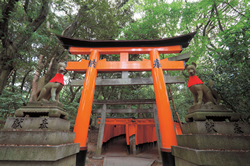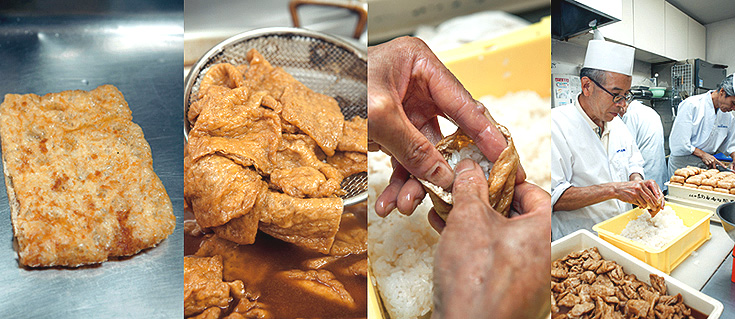niponica is a web magazine that introduces modern Japan to people all over the world.
2013 No.11

To read the e-book you need to have JavaScript enabled in your browser and a free Flash Player plug-in from Adobe Systems Inc. installed.
 Tasty Japan: Time to Eat!
Tasty Japan: Time to Eat!

Inari-zushi
Sushi rice wrapped in thin slices of deep-fried tofu
Photos: Arai Akiko, Aflo
Collaboration: Ningyo-cho Shinoda-zushi Sohoten Sushi Shop


The fox is represented in statue form at Fushimi Inari Taisha Shrine in Kyoto, and is venerated there.
Deep-fried tofu skin pouches simmered in a sweet and salty broth of soy sauce, sugar and mirin (a sweet sake seasoning), then stuffed with sushi rice—this is inari-zushi, a cheap food for everyday people that goes by the nickname, O-Inari-san.
Inari is deep-fried tofu (abura-age) sliced thin. The word comes from Inari shrines, where the fox has a place of honor. The word's origin is ine nari (rice grains forming on the stalk), and in the old days Inari shrines venerated Inari, the god of agriculture. Over time, the shrines focused on the servant of that god, who happened to be a fox. Foxes are said to love deepfried tofu, and from this came the custom of calling tofu skins inari.
In the Kanto region (eastern Japan) the tofu skin pouches are generally square, but in the Kansai region (western Japan), triangular. The sushi rice may be mixed with tiny pieces of simmered lotus root, carrot, or ginger pickled in ume plum vinegar.
Inari-zushi became a big seller in Edo (modern-day Tokyo) around the middle of the 1800s, and the business of a peddler selling this kind of sushi back then would later grow into the reputable shop featured here. The shop's roots go back to 1877, and it is located near traditional theaters in Tokyo's Ningyo-cho district. Members of the audience eat their boxed lunches—perhaps containing inari-zushi—between the acts of the play.
Inari-zushi is actually quite difficult to make because deep-fried tofu skin tends to crumble. The shop uses skins that are even thinner than you would find in a market. Thin is good, because only the right amount of broth soaks into the skins, so they will not wet the rice.
The deep-fried tofu pouches are soaked in 50ºC water for about 10 minutes to remove excess oil. Next, to make them tastier, they are simmered for two or three minutes in a broth containing three types of sugar, soy sauce and mirin. They are left at room temperature for one day, then in a refrigerator for about three days. It takes this amount of time for the tofu skins to fully absorb the delicious flavor.
After that, the pouches are simmered again, then stuffed with rice that has been seasoned with vinegar, salt and sugar. Expert sushi chefs open one end of the pouch with one hand, use the other to form a ball of seasoned rice without clumping, and fill the pouch gently. One stuffed pouch should weigh about 50 grams.
The shop sells the most inari-zushi on Inari shrine festival days. Even today, the roofs of some office buildings in the city have small shrines dedicated to Inari, and on the festival days you will see inari-zushi offerings placed there.
Perhaps the reason why this type of sushi goes by the affectionate nickname of O-Inari-san is because even today the Japanese still have a wish in their hearts for a good harvest.

Left: The shop uses deep-fried tofu skins that are thinner than those found in the market, to prevent too much seasoning from soaking in.
Center left: The tofu skins are dipped in broth.
Center right: Each salty-sweet tofu skin is stuffed with lightly vinegared rice.
Right: Ten seconds are all an expert sushi chef needs to fill one tofu skin with rice.


